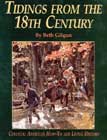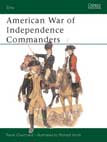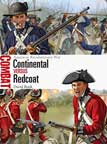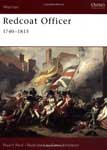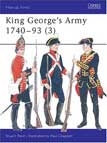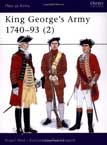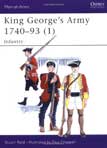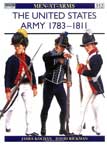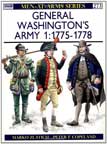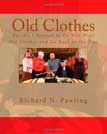

Beth Gilgun brings the mid to late 1700s to life with her entertaining and informative "letters" to a friend on the frontier. Great for reenactors, teachers, historic interpreters, and theatrical costumers. As an accomplished seamstress and goodwife, Gilgun shares with her "friend" information on clothing for men, women and children, as well as other topics of daily life in Colonial America. Included are clear, concise instructions for constructing reproduction 18th century garments, from choosing fabric to finishing. Her chatty letters include news about current events and the latest goods available on the East Coast.
*I met Beth Gilgun at a RevWar event once. I found her to be as neat in person as she seems in her books.
The commanders who led the opposing armies of the American War of Independence (1775–1783) came from remarkably different backgrounds. They included not only men from Britain and America, but from Germany, France and Spain as well. Some were from the great families of the "Old World," while others were frontiersmen or farmers in the "New World." Despite their differing origins, all were leaders in the events that led to the establishment of the United States of America. This book details the appearance, careers and personalities of the commanders on both sides. It covers such famous figures as George Washington and Lord Cornwallis along with less well-known men such as Admiral Suffren and Bernando de Galvez.
In June 1775 the Continental Congress, leading the American rebellion against the British Crown, created the Continental Army to serve in the line of battle alongside militia and "Provincial" units. Although supply problems, issues with discipline, and poor training hampered the Continentals' effectiveness in combat, they were able to inflict a decisive defeat on the British at Yorktown. In contrast, the backbone of the British forces in North America were long-service regular infantrymen, serving for the most part in single-battalion regiments. They had earned a formidable reputation on Europe's battlefields during the Seven Years' War, but in fighting the French in North America during that conflict had already learned a great deal about the very different fighting conditions prevalent in the New World.
In a host of encounters ranging from skirmishes to decisive pitched battles, the infantrymen of both sides would be tested to the limit, with supply problems, hostile terrain, and poor weather all adding to the horrors of close-quarter combat. Featuring full-color artwork, specially drawn maps, and archive illustrations, this engaging study offers key insights into the tactics, leadership, combat performance, and subsequent reputations of six representative Continental and Redcoat infantry regiments pitched into three pivotal actions that shaped the outcome of the American Revolutionary War.
The commissioned officer ranks in the British Army from 1740-1815 were almost entirely composed of the affluent and educated - the sons of the landed gentry, the wealthy, and other professional people. This title looks at the enlistment, training, daily life and combat experiences of the typical British officer in the crucial periods of the North American conflicts, the American Revolution, and the Napoleonic Wars. It compliments the author's previous treatments in Warrior 19 British Redcoat 1740-93 and Warrior 20 British Redcoat (2) 1793-1815, which deal exclusively with the common infantryman, and balances these discussions through a look at the 'fellows in silk stockings'. Particular emphasis is placed on the experiences and activities in North America in the late 18th century.
The 18th century was marked by a steady growth in central control of the British Army and a corresponding decrease in the influence enjoyed by individual commanding officers. The most obvious sign of this process was the increasing uniformity of the clothing issued each year to the soldiers. Nevertheless, as far as those who devised the Clothing Regulations were concerned, it was a constant, and invariably quite uphill struggle to enforce compliance. This companion volume to Men-at-Arms 285 and Men-at-Arms 289 examines the organization and uniforms of King George’s cavalry and artillery together with those of the Board of Ordnance.
The 18th century was marked by a steady growth in central control of the British Army and a corresponding decrease in the influence enjoyed by individual commanding officers. The most obvious sign of this process was the increasing uniformity of the clothing issued each year to the soldiers. Nevertheless, as far as those who devised the Clothing Regulations were concerned, it was a constant, and invariably quite uphill struggle to enforce compliance. This companion volume to Men-at-Arms 285 takes a further look at the infantry uniforms of the mid-18th century British Army, also covering the various auxiliary infantry formations, such as the Militia, Volunteers, Marines and the troops of the East India Company.
To most contemporary politicians the 18th century British Army was no more than an unwelcome necessity in wartime and an unjustifiable extravagance in peacetime. Nevertheless, the overall impression which is to be gained from a close study of the Army's own records, and from the surviving letters, diaries and memoirs, is that the British Army of the 18th century was very little different in character or in spirit from today's British Army. It was, above all, a force which was led, not driven, into battle. This book looks at the uniforms and organisation of the infantry of King George's Army as well as its participation in various conflicts, such as the War of the Austrian Succession (1740-1748) and the Seven Years' War (1756-1763).
When the Revolutionary War (1775-1783) ended Washington's victorious Continental Army was disbanded. The infant United States had very mixed feelings about standing armies; but years of Indian-fighting on the frontier emphasised the need for a force larger than Josiah Harmar's original 700-man 1st American Regiment. In the event Secretary Hamilton's far-sighted reforms, which produced 'Wayne's Legion' in the early 1790s, were to be short-lived, and it took later threats of international war to stimulate the eventual expansion of the young US Army. James Kochan's meticulously researched study of a dramatic and confused period in American military history - the years of St Clair's disaster, 'Mad Anthony' Wayne's victory at Fallen Timbers, and Harrison's at Tippecanoe - is illustrated with many rare and important paintings and drawings.
During the period 1775-78 of the American Revolutionary War, General Washington commanded three separate armies: the New England Army of 1775; the one-year army of the United Colonies, renamed Army of the United States in July 1776; and the forces established by the Continental Congress to serve for three years from January 1777, or for the duration. In this, the first of two studies by Marko Zlatich (Men-at Arms 290 continues the treatment, covering the period from 1779-83), the systems used by state and Continental authorities to procure clothing materials, the quantities they obtained and the specifications of the uniforms themselves are all examined in detail.
The history of the American rebellion against England, written by one of America’s preeminent eighteenth-century historians, differs from many views of the Revolution. It is not colored by excessive worship of the Founding Fathers but, instead, permeated by sympathy for all those involved in the conflict. Alden has taken advantage of recent scholarship that has altered opinions about George III and Lord North. But most of all this is a balanced history—political, military, social, constitutional—of the thirteen colonies from the French and Indian War in 1763 to Washington’s inauguration in 1789. Whether dealing with legendary figures like Adams and Jefferson or lesser-known aspects of a much picked-over subject, Alden writes with insights and broad eloquence.
This book is an indispensable guide to the often misunderstood field of living history. It presents the actuality that there is a great deal more involved in this discipline than merely “wearing old clothes and going back to the past.” This volume succinctly captures the perspectives that Richard Pawling has gained from over thirty-five years of experience in the interpretive profession (in county, state and national parks and as entrepreneur and owner of Rich Pawling’s History Alive!). Here, Pawling shares his observations and advice about everything from designing a living history persona to his successful use of this provocative teaching technique in the college classroom, to the role of research in helping you to learn about your own genealogical past. Though written for a broad audience, this book should be of particular interest to those employed as an interpretive park ranger or a naturalist, a museum or tour guide, or those who volunteer as a military reenactor or as a docent at a park, museum or historic site. Old Clothes presents the important lessons Pawling has learned along the way, the most important of which is that “life is a journey and understanding our past plays an important role in helping us to continue to learn not only about life in general, but more importantly, about ourselves.”
Pope Julius II excommunicates Italian state of Venice
Treaty of St. Truiden: anti-French Trapdoors / Bourgondisch covenant
Battle at Bicacca: Charles I and Pope Adrianus VI beat France
Mogol King Babur beats Sultan of Delhi
1st Spanish settlement in Philippines, Cebu City, forms
Peace of Beaulieu and Paix de Monsieur
King Charles I flees Oxford
Scottish general Montrose defeated
Netherlands and France sign military covenant
Frederik August I "the Strong" becomes Monarch of Saksen
Battle at Culloden Moor: Duke of Cumberland beats "James VIII & III"
US Marines attack shores of Tripoli
Americans under General Pike capture Toronto; Pike is killed
Fire destroys half of Charleston
Imakita Kosen, 1st Zen teacher of D.T. Suzuki, found the awakening
Establishment of Jewish congregations in Lower Austria prohibited
"Pomona" sinks in North Atlantic drowning all 400 aboard
Thomas J Jackson is assigned to command Harpers Ferry
President Abe Lincoln suspends writ of habeas corpus
West Virginia secedes from Virginia after Virginia secedes from US
Cornell University (Ithaca NY) is chartered
Heinrich Schliemann discovers Troi
White League, Paramilitary white supremacist organization, forms
Opera "Le Roi de Lahore" is produced (Paris)
President Hayes removes Federal troops from LA, Reconstruction ends
Pogroms against Russian Jews start in Elisabethgrad
1st Highlander (Yankee) shut-out, Philadelphia Athletics win 6-0
World Exposition opens in Luik
Sultan of Turkey Abdul Hamid II is overthrown
Belgian parliament rejects socialist motion for general voting rights
Relief laws replaces those of 1854, in the Netherlands
Pogrom leader Petljoera declares Ukraine Independence
Hadjememaar, [Corn de Gelder] elected in Amsterdam
Fritz Langs "Dr Mabuse, der Spieler" premieres in Berlin
Yakut ASSR formed in Russian SFSR
Mussolini government italian place in South Tirol / Alto Adige
Antwerp soccer tie Belgium-Netherlands 1-1
Karl Jansky reports reception of cosmic radio signal in Washington DC
Yanks pull a 1st inning triple-play and beat Philadelphia Athletics 9-8
1st US social security payment made
US Social Security system makes its 1st benefit payment
Himmler orders establishment of Auschwitz Concentration Camp
German troops occupy Athens Greece
Belgium Jews are forced to wear stars
Tornado destroys Pryor Oklahoma killing 100, injuring 300
Lou Jansen and Jan Dieters arrested, lead illegal CPN party in Holland
Soviet Union breaks contact with Polish government exiled in London
Boston Brave Jim Tobin no-hits Brooklyn Dodgers, 2-0
2nd Republic of Austria forms
Italian partisans capture Mussolini prisoner
US 5th army enters Genua
1st radar installation aboard a coml ship installed
Babe Ruth Day celebrated at Yankee Stadium and through out US
Arab legion attacks Gesher bridge on Jordan River
"Tickets, Please" opens at Coronet Theater NYC for 245 performances
South Africa passes Group Areas Act segregating races
Mohammed Mossadeq chosen Premier of Persia
"4 Saints in 3 Acts" closes at Broadway Theater NYC after 15 performances
1st general elections in British Guyana, won by Jagans PPP
Wrestler Freddie Blassie coins term "Pencil neck geek"
Heavyweight champ, Rocky Marciano, retires undefeated from boxing
"Today" show goes abroard 1st time (Paris France)
Liu Sjau-chi elected President of China PR
1st atomic powered electric-drive submarine launched (Tullibee)
South Korean President Syngman Rhee resigns
Togo (formerly French Togo) declares independence from French adm
NASA launches Explorer 11 into Earth orbit to study gamma rays
NFL officially recognizes Hall of Fame in Canton, Ohio
Sierra Leone declares independence from the UK
"Jopie" Pengel forms government in Suriname
Cuban Premier Fidel Castro arrives in Moscow
RC Duncan patents "Pampers" disposable diaper
Dmitri Shostakovitch completes his 2nd cello concert
Rocky Marciano retires as undefeated boxing champ
"Education of Hyman Kaplan" closes at Alvin NYC after 28 performances
Baltimore Oriole Tom Phoebus no-hits Boston, 6-0
Congress of Political Party Radicals (PPR) forms in the Netherlands
Carol Mann wins LPGA Raleigh Ladies Golf Invitational
Curt Flood resigns Senators after 13 games and departs for Denmark
Apollo 16 returns to Earth
New York City Mayor John Lindsey appeals that John Lennon not be deported
Kansas City Royal Steve Busby no-hits Detroit Tigers, 3-0
Pan Am 707 crashes into mountains of Bali, killing 107
Sandra Haynie wins LPGA Charity Golf Classic
"So Long 174th St" opens at Harkness Theater NYC for 16 performances
Arabic Monetary Fund established in Abu Dhabi
Bloody riots in Soweto South Africa
HCC, Hobby Computer Club, forms in the Netherlands
Accident at nuclear reactor Willow Island, W Virginia, kills 51
George Harrison releases "Love Comes to Everyone"
Barbara Barrow wins LPGA Birmingham Golf Classic
1st female soccer official is hired by NASL
Beatle Ringo Starr marries actress Barbara Bach [Goldbach]
Nordiques 1-Isles 4 - Semifinals - Isles hold 1-0 lead
Trial of John W Hinckley Jr attempted assassin of Reagan, begins
Nolan Ryan becomes strikeout King (3,509), passing Walter Johnson
Cleveland Indians beat Detroit Tigers, 8-4, in 19 innings
Over 70 inches of snow falls on Red Lake, Montana
"Sweet Charity" opens at Minskoff Theater NYC for 368 performances
Captain Midnight (John R MacDougall) interrupts HBO
Pat Bradley wins LPGA S&H Golf Classic
US Justice Department bars Austrian Chancellor Kurt Waldheim from entering US, due to his aid of Nazi Germany during WWII
"Starmites" opens at Criter Ctr SR Theater NYC for 60 performances
Beijing students take over Tiananmen Square in China
Hurricane in Bangladesh, kills 500
Mandatory seatbelt law goes into effect in Italy
50th annual barbershop quartet singing convention held (Mich)
Dodger Orel Hershiser undergoes career-threatening shoulder surgery
Firestone World Bowling Tournament of Champions won by David Ozio
"Small Family Business" opens at Music Box Theater NYC for 48 performances
New York Jets finish perfect 5-0 pre-season for 1st time
New York Mets trade David Cone to Toronto Blue Jays for Jeff Kent
Afghan Antonov AN-32 crashes at Tashqurgan, kills 76
"Inspector Calls" opens at Royale Theater NYC for 454 performances
7th longest NHL game: New Jersey Devils beat Buffalo Sabres (125 min 43 seconds)
Graeme Obree bicycles world record time (52,713 km)
President Nixon buried in Nixon Library in California
Twins righty Scott Erickson no-hits Brewers 6-0
"Indiscretions" opens at Ethel Barrymore Theater NYC for 221 performances
Coors Field in Colo opens - Denver Rockies beats Mets 11-9 in 14
"Little Foxes, " opens at Vivian Beaumont NYC for 56 performances
"Stanley, " closes at Circle in the Square Theater, New York City
Frank Nobilo wins Greater Greensboro Chrysler Classic at Forest Oaks
Las Vegas Senior Golf Classic by TruGreen-ChemLawn
Nancy Lopez wins LPGA Chick-fil-A Charity Championship
